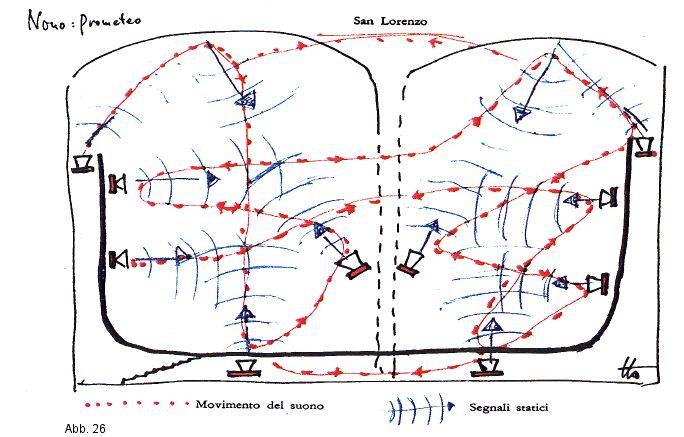HaLaPhon & Luigi Nono
Principle
The HaLaPhon, developed by Hans Peter Haller at SWR in the 70s and 80s, is a device for spatialized performances of mixed music, and live electronics. The first version was a fully analog design, whereas the following ones used analog signal processing with digital control. The HaLaPhon principle is based on digitally controlled amplifiers (DCA), which are placed between a source signal and loudspeakers. It is thus a channel-based-panning paradigm. Source signals can be tape or microphones:

DCA (called 'Gate') in the HaLaPhon.
Each DCA can be used with an individual characteristic curve for different applications:

DCA: Different characteristic curves.
Quadraphonic Rotation
A simple example shows how the DCAs can be used to realize a rotation in a quadraphonic setup:

Circular movement with four speakers.

Quadraphonic setup with four DCAs.
Envelopes
The digital process control of the HaLaPhon generates control signals, referred to as envelopes by Haller. Envelopes are generated through LFOs with the following waveforms:

Circular movement with four speakers.
Envelopes for each loudspeaker gain are synchronized in the control unit, resulting in movement patterns. These can be stored on the device and triggered by the sound director or by signal analysis:

Quadraphonic setup with four DCAs.
Prometeo
Haller worked with various composers at SWR. His work with Luigi Nono, especially the ambituous Prometeo, showed new ways of working with the live spatialization of mixed music. The HaLaPhon's source movements could be triggered and controlled by audio inputs, thus merging sound and space more directly.

Construction for 'Prometeo' in San Lorenzo (Venice).

Sketch of spatial sound movements in 'Prometeo'.
References
2018
- Christoph von Blumröder.
Zur bedeutung der elektronik in karlheinz stockhausens œuvre / the significance of electronics in karlheinz stockhausen's work.
Archiv für Musikwissenschaft, 75(3):166–178, 2018.
[abstract▼] [details] [BibTeX▼]
2015
- Martha Brech and Henrik von Coler.
Aspects of space in Luigi Nono's Prometeo and the use of the Halaphon.
In Martha Brech and Ralph Paland, editors, Compositions for Audible Space, Music and Sound Culture, pages 193–204.
transctript, 2015.
[details] [BibTeX▼] - Michael Gurevich.
Interacting with Cage: realising classic electronic works with contemporary technologies.
Organised Sound, 20:290–299, 12 2015.
doi:10.1017/S1355771815000217.
[details] [BibTeX▼]
2011
- John Chowning.
Turenas: the realization of a dream.
In Proceedings of the 17th Journées d\rq Informatique Musicale. 2011.
[details] [BibTeX▼]
2010
- Peter Moormann.
Raum-musik als kontaktzone. stockhausens hymnen bei der weltausstellung in osaka 1970.
Paragrana, 19(2):33–43, 2010.
URL: https://doi.org/10.1524/para.2010.0023, doi:doi:10.1524/para.2010.0023.
[details] [BibTeX▼]
2008
- Marco Böhlandt.
“kontakte” – reflexionen naturwissenschaftlich-technischer innovationsprozesse in der frühen elektronischen musik karlheinz stockhausens (1952–1960).
Berichte zur Wissenschaftsgeschichte, 31(3):226–248, 2008.
[details] [BibTeX▼] - Jonas Braasch, Nils Peters, and Daniel Valente.
A loudspeaker-based projection technique for spatial music applications using virtual microphone control.
Computer Music Journal, 32:55–71, 09 2008.
[details] [BibTeX▼]
